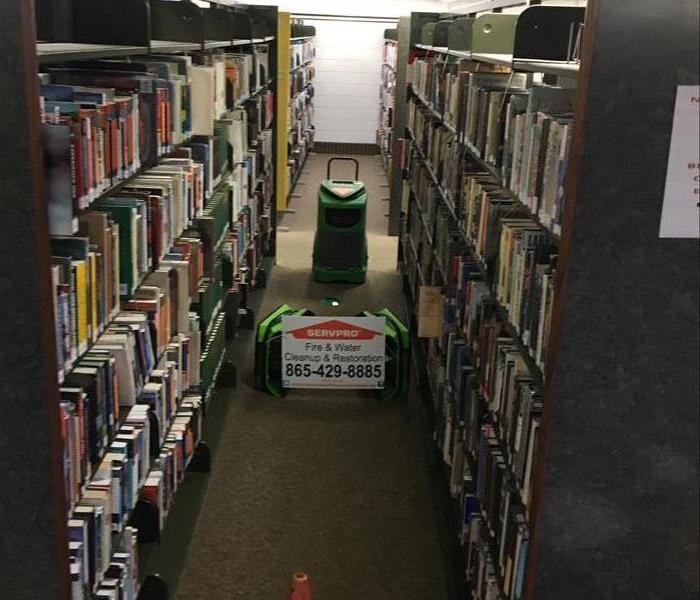Does Water Cause Continuous Harm to a Property?
11/2/2020 (Permalink)
 Sevierville Properties benefit from SERVPRO's fast water removal services using advanced drying equipment. We even save books.
Sevierville Properties benefit from SERVPRO's fast water removal services using advanced drying equipment. We even save books.
Without Expert Water Mitigation, your Sevierville Home Could Suffer Extensive Losses. SERVPRO Has Water Restoration Technicians Ready to Help.
Is water intrusion in a property an urgent problem?
When large amounts of water enter an indoor environment that is not built to sustain it, severe damages can occur. A water intrusion event in your Sevierville home can affect materials, contents, and building structures. Microbes found in water can reproduce and begin to digest organic matter, which could be carpet fibers, textiles, or wood constructs like the Gypsum board. There are numerous reactions involving moisture that can occur in your property leading to expensive restoration such as condensation, dew points, evaporation, vapor pressure, and airflow. SERVPRO is a trained and qualified restoration service that can prevent these types of loss at residential properties.
What does water do to an indoor environment?
The goal of water mitigation in your Sevierville home is to negate water exposure's effects on structure and contents. Moisture absorbs into surfaces, especially porous ones, and could cause expensive damages. Some of these damages may be discolored or odorous. Others may present problems like structural weakening or sagging to build materials. Floor finishes like hardwoods can change shape leading to cupping and buckling. These types of harm can be avoided providing that you enlist an expert water technician to assess the property and mitigate losses. SERVPRO is a local provider with nationally recognized qualifications in water restoration.
How does evaporation affect an indoor structure?
- Evaporating moisture can raise the relative humidity within the structure, providing ideal conditions for microbial growth.
- As water combines with air, it can migrate throughout the home leading to condensation spots on surfaces, walls, or ceilings
- Evaporating moisture can crack paintwork or create bubbles on surfaces that come into contact with the humidity.
What are condensation issues in a property?
Condensation refers to the process of water vapors, transforming into liquids. When water vapors cool, they convert back into a liquid. These can cause your home issues during a water intrusion event as moisture spots appear in wall cavities and require specific drying equipment to remove. Moisture spots can also lead to mold growth without careful attention. Our technicians can deploy heaters and dehumidifiers into your property to ensure that the surrounding air holds more moisture and that water vapor is replaced by dry air. Managing a water loss site requires the expert application and technical equipment placement of dehumidifiers to prevent condensation-related damages in your home.
What is the dew point, and how does it affect restoration?
- The temperature that water vapors return to liquid is known as the dew point.
- If water vapor reaches the dew point, it can condensate onto inner walls causing extensive damage.
- Maintaining air temperature above the dew point allows for faster evaporation as hot air can retain more moisture than cold air.
How does the dew point affect electronic devices?
Our homes are full of electronic devices, from TVs to tablets and laptops. Once an electrical appliance has water exposure, it is essential to keep the machine off and remove all power sources- these can short-circuit, causing permanent harm. Instead, SERVPRO technicians seek to maintain indoor temperatures above the dew point and mitigate against condensation damage affecting your electrical devices. We can arrange for an electronics specialist to inspect and potentially repair wet electronic equipment in your home. Our subcontracting services are included within your restoration estimate, which means you only have to deal with one point of contact during mitigation services.
How does vapor pressure affect drying times in a wet property?
- Water vapor from evaporating moisture can push against surfaces, creating pressure.
- The more significant amounts of vapor in the air, the higher the level of pressure becomes
- Efficient drying times are created by maintaining a low vapor pressure in the property by removing moist air and replacing it with dry air.
How do water restoration technicians control evaporation, dew points, and condensation in a wet property?
The most effective method of mitigation in your home is to dry it quickly. By drying a property, we can avoid costly events such as microbial growth, discoloration, cracking, warping, and buckling of materials. Evaporation of liquid water is enhanced by providing consistent airflow and high temperature in a property. SERVPRO technicians create these conditions using rapid air-movers and portable heaters or furnaces. To prevent condensation damage, we draw moisture from the air, maintained above the dew point, using dehumidification equipment. Properties with long periods of water exposure may suffer damage to semi-porous materials like floorboards. These can be dried using desiccant dehumidifiers to reduce air moisture below 40 grains per pound in cold temperatures and draw water from inside semi-porous materials.
Quick-drying times are essential to mitigating potential losses in your home. Contact SERVPRO of Sevier, Jefferson & Cocke Counties at (865) 429-8885 now.






 24/7 Emergency Service
24/7 Emergency Service